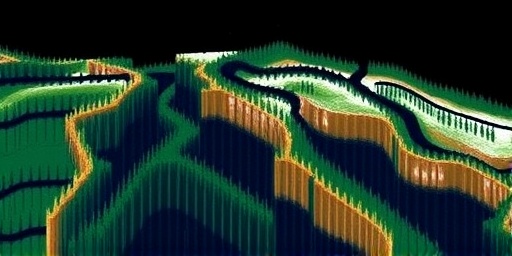Satellite Imagery Exposes Rapid Tree Line Advances Across Global Peaks
In a startling revelation that’s reshaping our understanding of ecological dynamics, satellite imagery has captured Forests creeping upward along mountain slopes at unprecedented rates. Researchers analyzing decades of data from high-resolution satellites report that tree lines—the boundaries where Forests give way to treeless alpine zones—are migrating to higher elevations in regions from the Alps to the Rockies. This shift, observed over the past 30 years, averages about 10 meters per decade, far quicker than historical norms. But here’s the twist: experts now argue this isn’t primarily fueled by the warming trends associated with climate change, challenging long-held assumptions in environmental science.
- Satellite Imagery Exposes Rapid Tree Line Advances Across Global Peaks
- Decoding the Data: How Satellite Tech Tracked Forest Encroachment
- Alternative Forces Driving Tree Line Shifts Beyond Climate Warming
- Global Case Studies: Tree Line Transformations in Key Mountain Ranges
- Conservation Challenges and Future Research Directions for Shifting Forests
The findings, published in a recent issue of the journal Nature Ecology & Evolution, stem from a collaborative effort by scientists at the University of Zurich and NASA’s Earth Observation program. Using advanced satellite imagery from Landsat and Sentinel missions, the team mapped vegetation changes with pinpoint accuracy. ‘What we’re seeing is a mosaic of green pushing against the white snow caps, but the drivers are more complex than a simple temperature rise,’ said lead researcher Dr. Elena Vasquez, a forest ecologist. This discovery upends the narrative that global warming alone is propelling trees to colonize cooler, higher altitudes, prompting a reevaluation of how we monitor and protect mountain ecosystems.
Mountains, which cover about 25% of Earth’s land surface, host unique biodiversity hotspots where tree lines act as natural barriers. Traditionally, scientists attributed upward shifts to climate change, as warmer temperatures allow trees to survive in previously frigid zones. However, this new analysis of satellite imagery suggests other factors are at play, including land-use changes and natural recovery processes. The implications ripple through conservation strategies, as policymakers grapple with how to safeguard Forests that are reshaping themselves in unexpected ways.
Decoding the Data: How Satellite Tech Tracked Forest Encroachment
At the heart of this breakthrough is cutting-edge satellite imagery, which has revolutionized how we observe remote mountain terrains. Unlike ground-based surveys, which are labor-intensive and limited by rugged access, satellites provide a bird’s-eye view of vast areas. The study leveraged multispectral imaging from satellites orbiting at 700 kilometers altitude, capturing reflected light in wavelengths that distinguish tree cover from shrubs, grass, or bare rock. Over 5,000 images spanning 1984 to 2020 were processed using machine learning algorithms to detect subtle shifts in the tree line.
Key statistics from the research highlight the scale: in the European Alps, tree lines have advanced by up to 50 meters in elevation since the 1990s, while in the Sierra Nevada mountains of California, similar gains of 30-40 meters were noted. ‘Satellite imagery doesn’t lie—it’s showing us forests that are literally climbing the peaks,’ Vasquez explained in an interview. The technology’s resolution, now down to 10 meters per pixel, allows for precise tracking of individual tree species like pines and firs encroaching on alpine meadows.
Challenges in interpreting this data include accounting for seasonal variations and cloud cover, which can obscure up to 30% of mountain imagery. Researchers mitigated this by cross-referencing with ground validation from drone surveys and historical photographs. What emerged was a clear pattern: tree line migration is widespread but inconsistent, accelerating in some areas like the Andes and stalling in others, such as parts of the Himalayas. This variability underscores the need for global monitoring networks, with organizations like the European Space Agency calling for expanded satellite constellations dedicated to ecological surveillance.
Alternative Forces Driving Tree Line Shifts Beyond Climate Warming
While climate change has long been the prime suspect in tree line dynamics, this study posits that human and natural influences are the real architects of these migrations. Reduced grazing by livestock in mountainous regions, for instance, has allowed saplings to flourish where they once faced browsing pressure. In the Swiss Alps, a 40% decline in sheep farming since the 1980s correlates directly with observed forest expansions, as per agricultural census data integrated into the satellite analysis.
Another factor is fire suppression and natural regeneration following historical disturbances. In North American mountains, policies limiting wildfires have enabled forests to rebound and push upward. ‘Climate change might provide the warmth, but it’s land management that’s opening the door,’ noted co-author Dr. Marcus Hale from the USDA Forest Service. Statistics show that in areas with active reforestation programs, tree lines have shifted twice as fast as in unmanaged zones, suggesting human intervention amplifies natural processes.
Soil and hydrology play roles too. Improved moisture retention from reduced erosion—linked to less intensive farming—supports tree growth at higher altitudes. In the Pyrenees, satellite imagery revealed a 15% increase in soil organic matter coinciding with tree line advances. Yet, not all news is positive: invasive species, detected via spectral signatures in satellite data, are hitching rides on these migrations, potentially disrupting native alpine flora. This multifaceted view challenges the oversimplified climate narrative, urging a holistic approach to studying forests in mountains.
Global Case Studies: Tree Line Transformations in Key Mountain Ranges
Zooming in on specific locales, the study delineates varied patterns of tree line migration. In the Rocky Mountains, satellite imagery from 1990 onward shows lodgepole pines advancing 20 meters per decade, attributed partly to elk population controls that eased herbivory. Local ecologists report a 25% increase in forest cover at elevations above 3,000 meters, transforming habitats for species like the American pika, which rely on open tundra.
Across the Atlantic, the Scandinavian mountains exhibit slower but steady shifts, with birch forests gaining ground amid declining reindeer herds. Norwegian researchers, contributing to the study, used satellite data to quantify a 10-meter rise every five years, linking it to post-industrial recovery rather than solely to warming. ‘Our mountains are healing from centuries of overuse, and satellites are our witnesses,’ said Dr. Ingrid Larsen of the University of Oslo.
In Asia’s rugged terrain, the Tibetan Plateau presents a contrasting story. Here, satellite imagery indicates sporadic tree line retreats in overgrazed areas, bucking the upward trend elsewhere. This anomaly highlights how overexploitation can counteract potential climate benefits, with deforestation rates in some sectors reaching 2% annually. These case studies, drawn from over 20 mountain systems worldwide, emphasize the interplay of local factors in global forest dynamics, informing tailored conservation efforts.
Conservation Challenges and Future Research Directions for Shifting Forests
As tree lines migrate, conservationists face new hurdles in preserving mountain biodiversity. Upward forest expansion risks squeezing out specialized alpine plants and animals, with models predicting a 20-30% loss of high-elevation habitats by 2050. Protected areas like national parks may need boundary adjustments to encompass these dynamic frontiers, a logistical nightmare in steep terrains.
Experts advocate for integrated strategies, blending satellite monitoring with on-the-ground interventions. ‘We must adapt our policies to these living landscapes,’ urged Vasquez, calling for international funding to enhance satellite imagery resolution for real-time tracking. Upcoming missions, such as NASA’s Surface Water and Ocean Topography satellite, promise even finer details on how water cycles influence tree line shifts.
Looking ahead, interdisciplinary research will dissect these drivers further, potentially incorporating AI to predict migration hotspots. Policymakers are already responding: the UN’s Mountain Partnership Initiative plans workshops on land-use reforms to balance forest growth with biodiversity needs. As mountains continue to evolve, this study serves as a clarion call for nuanced environmental stewardship, ensuring that the ascent of forests benefits ecosystems rather than overwhelming them.







